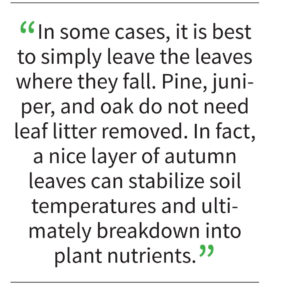Autumn leaves make excellent compost. Mix “brown” material with equal parts “green” material
By Kate Russell
As Morgan Hill trees drop their leaves in autumn, you might want to consider a few things before you rake them up and kick them to the curb.
We have all heard the myth that leaving autumn leaves on your lawn will kill it.
 As with many other myths, this one is partly fact and partly fiction. It is true that especially thick layers of intact leaves can halt the growth of whatever happens to be underneath and may interfere with soil respiration.
As with many other myths, this one is partly fact and partly fiction. It is true that especially thick layers of intact leaves can halt the growth of whatever happens to be underneath and may interfere with soil respiration.
This is particularly true when there are heavy rains or snowfall. If you have that many leaves, it is a good idea to chip them, or chop them with your lawnmower to speed up the decomposition process.
In some cases, it is best to simply leave the leaves where they fall. Pine, juniper, and oak do not need leaf litter removed. In fact, a nice layer of autumn leaves can stabilize soil temperatures, reduce weed growth, and ultimately breakdown into plant nutrients.
Fallen leaves can harbor pests and diseases. A pile of dry, curled up leaves can provide sanctuary to countless insects, bacteria, fungi, and viruses, some of which can be very harmful to your landscape and garden plants.
To prevent some of these problems, collect fallen leaves from under fruit and nut trees, rose bushes, rhododendrons, camellias, and azaleas. You can then add them to your compost pile or put them out as yard waste pickup. Your fruit and nut trees will benefit from a mulch of free arborist wood chips. Just make sure that the wood chip mulch does not come into direct contact with the plants being protected, as fungal diseases can occur.
Autumn leaves make excellent compost, but you have to mix all that “brown” material with equal parts “green” material. That green material can be lawn clippings, spent garden plants, and kitchen waste. Just be sure to chop the leaves first, either with a chipper or a lawn mower.
If you wait until the leaves are really dry, you can encourage your kids to jump around on them, smashing them to bits. Once the leaves have been broken down, they can be mixed with green material and kept moist for some amazing soil amendments next spring.
Leaves can be used as plant foods and soil amendments without spending any money. The only exception might be leaves that are exposed to a lot of car exhaust.
You probably do not want to add those amendments to your soil. Instead, leaves from trees along busy streets should be disposed of as yard waste and not composted.
All those bright, colorful autumn leaves can provide your Morgan Hill lawn, landscape, and garden with healthier soil without raking them all up and throwing them away. Simply allow them to break down and let Mother Nature take its course while you enjoy the holidays!







